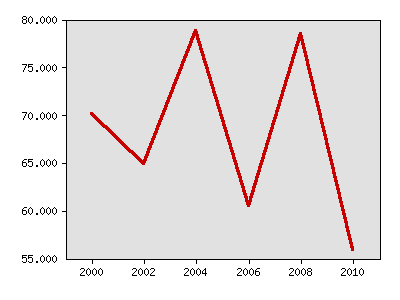Indicator 29: Voter Turnout


Goal: All people will be welcomed, respected and able to participate fully in Minnesota's communities and economy.
Rationale: High voter turnout is an indicator that people are interested and believe they can make a difference in government. This goal reflects Minnesotans' desire for open and representative government, as well as the belief that broad-based and energetic citizen participation in the political process and civic affairs is a sign of a healthy democracy.
About this indicator: In the 2010 general election, 55.9 percent of eligible Minnesota voters went to the polls. This was considerably below the voting level in the 2008 Presidential election, 78.4 percent, and also lower than in the previous off-year election, 60.5 percent.
Percent of eligible Minnesotans who voted in state general elections

| Year | Data |
|---|---|
| Percent of eligible Minnesotans who voted in state general elections, Minnesota Secretary of State | |
| 2000 | 70.1% |
| 2002 | 64.9% |
| 2004 | 78.8% |
| 2006 | 60.5% |
| 2008 | 78.5% |
| 2010 | 55.9% |
For comparison: Minnesota had the highest voting rate of all states in the 2010 election, 55.5 percent, ahead of second-place Maine with 54.5 percent. This measure of voting is slightly different than the one cited above. It is based on the turnout rate for the office with the highest number of votes cast. The numbers cited above are based on total ballots cast rank. Total ballots cast is considered a better indicator of participation, but not all states provide the data.
Technical notes: Different results would be obtained using the total voting-age population instead of the estimated number of eligible voters as the denominator. People who are not citizens or are ex-felons still on parole status may not vote. Residents living abroad may be eligible to vote but do not appear in the population estimates. For these reasons, many consider a measure based on eligibility to be more meaningful. Data on age is easier to find, however.
Sources:
- Minnesota Secretary of State. The data are compiled by Dr. Michael McDonald of George Mason University. Historical Minnesota voting turnout, http://www.sos.state.mn.us/index.aspx?page=137
- United States Election Project, http://elections.gmu.edu/voter_turnout.htm
Related 2002 Milestones indicator:
Local data:




